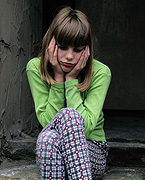
MONDAY, Feb. 17, 2014 (HealthDay News) — Kids who are picked on by their peers may see lasting effects on their physical and mental well-being — especially if the bullying is allowed to persist for years, a new study suggests.
The study found that kids who are chronically bullied seem to fare the worst: Those continually picked on from fifth grade to 10th grade had the lowest scores on measures of physical and emotional health.
Kids who were bullied at a younger age but saw the problem fade tended to do better. But they were still worse off than their peers who’d never been victimized.
“I think the message is straightforward,” said study lead author Laura Bogart, a scientific researcher at Boston Children’s Hospital. “The effects of bullying compound over time, and it’s important to catch it early.”
The findings are based on nearly 4,300 children from three U.S. cities who were surveyed in fifth, seventh and 10th grades — or roughly the ages of 10, 12 and 15. Overall, 30 percent said they were being regularly bullied on at least one survey.
That meant they were being physically pushed around, or teased, at least once a week.
In general, Bogart’s team found, kids who were bullied reported more physical problems — difficulty playing sports, running or doing normal “kid things” — than their peers. They also had more depression symptoms and lower self-esteem.
The outlook was worst for the 3 percent to 4 percent of kids who were continually bullied over time. By 10th grade, 45 percent of teens who’d been chronically victimized fell into the category of “low” mental well-being.
That compared with 31 percent of kids who reported current bullying only, and 12 percent of those who’d been bullied in the past only. Of students who’d never been regularly picked on, just 6 percent scored that low in psychological well-being.
The findings cannot prove that bullying caused kids’ mental and physical woes, Bogart said.
But, she added, her team accounted for some other factors that can affect kids’ odds of being bullied and their health, such as obesity and chronic illnesses. They also factored in family income and kids’ race, gender and sexual orientation.
Bullying, itself, was still linked to worse well-being.
Plus, there is plenty of research pointing to the ill effects of bullying — and this study offers more evidence, according to David Finkelhor, who directs the Crimes Against Children Research Center at the University of New Hampshire, in Durham.
The study, published online Feb. 17 in Pediatrics, “adds one more element to the growing priority of preventing peer victimization and helping those affected by it,” said Finkelhor. He was not involved in the research.
A limit of the study, he said, is that it had no information on other types of victimization kids can face, such as abuse from parents and witnessing domestic violence.
More and more, Finkelhor said, studies are showing that it’s those kids — victimized in multiple ways — who “carry the biggest scars as they move on.”
When it comes to bullying from peers, study author Bogart said, the new findings underscore the importance of prevention, or putting a stop to it as soon as possible.
She noted that most states now require schools to have anti-bullying policies. The good news, Finkelhor said, is that prevention programs are expanding “rapidly” in U.S. schools.
As for what parents can do, Bogart said they can look for signs their child is being bullied. That includes signs of physical bullying, like cuts and bruises — and subtler signals, such as acting withdrawn or not wanting to go to school.
But it’s also important that kids learn not to be silent bystanders to bullying, Bogart said. Both schools and parents, she noted, can teach children to speak up when they see a classmate being picked on.
More information
For more advice, visit the U.S. Department of Health and Human Service’s Stop Bullying website.
Copyright © 2025 HealthDay. All rights reserved.

